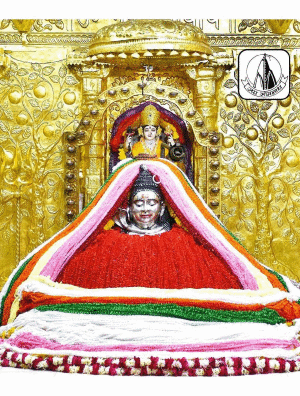Difference between revisions of "The magnificence of Somnath Temple"
m (Text replacement - "”" to "") |
(gif added) |
||
| (2 intermediate revisions by 2 users not shown) | |||
| Line 1: | Line 1: | ||
| − | + | [[File:Somnath Temple.gif|thumb|Somnath Mahadev Temple, Near Veraval City, Prabhas Patan, Gujarat]] | |
| + | {{ToBeEdited}} | ||
== Gujarat: Jewel of Western India == | == Gujarat: Jewel of Western India == | ||
| Line 22: | Line 23: | ||
== References == | == References == | ||
| + | [[Category:Temples]] | ||
Latest revision as of 12:22, 28 March 2019
| This article needs editing.
Add and improvise the content from reliable sources. |
Gujarat: Jewel of Western India
The land of Gujarat, known as the jewel of Western India can be said to be one of the myriad jewels of Bharat as a whole. Gujarat’s language, script and its temples are integral parts of its long and glorious history. The oldest written record of Gujarat's history is in a 2000-year-old Greek book titled 'The Periplus of the Erythraean Sea: Travel and Trade in the Indian Ocean'. Gujarat as the rest of BharatVarsha was a part of the highly advanced Indus Valley Civilization. Notably, the famous and magnificent Dwarkadhish Temple has been mentioned in the book before being reconstructed a it was pillaged by foreign invaders.
The Somanath Temple
Looted, destroyed and resurrected 17 times, the temple city of Somnath or Prabhas Patan is situated in the state of Gujarat on the Arabian Sea houses one of the 12 Jyotirlings of Bhagwan Shiva. This temple has its own story of enduring centuries, undergoing reconstruction several times.
History
It is said that the original temple of Somnath was built by the Moon God and was made of gold. After it was razed to the ground, it was rebuilt with silver by Ravana. When the silver temple was knocked down, it was reconstructed in wood by Krishna. And when this was pulled down, an edifice of stone was erected by Bhimdev.
The first acknowledged history of the temple dates to the second form of this temple was said to be built at the same site by the Yadava kings around 649 BCE. Like most temples in Bharat, this second form was destroyed in 725 BCE by an Arab Governor. The temple was reconstructed by king Nagabhata II who created it as a large structure of sandstone in 815 BCE. In AD 1026, Mahmud of Ghazni first looted the temple, and then came Afzal Khan, the commander of Ala-ud-din Khilji and later Aurangzeb. It is said that the temple was looted and destroyed as many as seventeen times. So on, it was continually reconstructed by Hindu Kings and destroyed by different rulers from other religions, intruders, Mughals and by the East India Company’s traders and evangelists. Though the temple seemed to regain its glory after the 18th century, it is nowhere close to its original form.
Historical significance
The Temple is believed to be the Primary or the First Jyotirlinga among the 12 Jyotirlingas in Dharmic tradition. Lord Shiva is said to have appeared in a fiery column of light from this Linga. The Linga is also believed to be Swayanbhu (self–born) in nature and is worshiped by millions of people in India and around the world. Since ancient times, Prabhas Patan has been a pilgrimage center, being the confluence of the rivers Saraswati, Hiranya and Kapila. Legend has it that Lord Shiva’s Kalbhairav linga is situated at Prabhas. The temple is popularly known as Somnath (the one named after the moon) as the Moon God is said to have worshipped this Shivling.
It is said that, Syamantak Mani (the Philosopher’s stone) associated with Lord Krishna is hidden inside Shiva Linga in the temple. This stone is supposed to have the magical ability to produce gold. It is believed that it is responsible for creating a magnetic field around itself which keeps the Linga floating above the ground. The Linga is made of iron and the roof of the sanctum is made of loadstone. The shrine is built in such a way that the magnetic force exerted by the loadstone kept the Linga floating in the air. It is believed that one can wash away one’s sins by taking a dip in the holy waters of the Someshwar Kund. This Kund was built in honour of Lord Shiva after he removed the curse on Chandra (the moon God). Prabhas Pattan, the ancient pilgrimage site close by is considered holy as it is the Sangam (confluence) of the three great rivers– the Saraswati, the Hiranya and the Kapila. Prabhas Pattan is where Lord Krishna was struck by an arrow while resting under a tree. He started his final journey in life from here.
Present day Somanath Temple
The Iron man of India, Sardar Vallabhbhai Patel was instrumental in the construction of the present temple, an edifice reminding visitors of the splendor of the original Somnath temple. Renowned temple architect Prabhaschandar designed it and the first President of India Dr. Rajendra Prasad installed the Jyotirling in the new temple on May 11, 1951.

